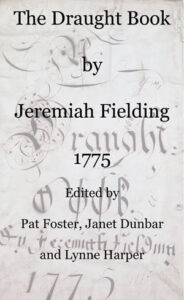SDA Book Club: The Draught Book reviewed by Katie Taylor
February 4, 2022
This month’s addition to the SDA Book Club comes to us from SDA’s Advertising and Outreach Manager, Katie Taylor.

The Draught Book by Jeremiah Fielding, 1775 (edited by Pat Foster, Janey Dunbar and Lynne Harper)
The Draught Book by Jeremiah Fielding takes the reader on a trip back in time to explore a variety of weaving drafts for commercial cotton cloth made in Lancashire, UK in the last quarter of the 18th Century. These drafts were originally compiled in a rough notebook by Mr. Warren Wood in 1953, then handed down to his daughter Rosemary Booth who has allowed Pat Foster to borrow the originals. These historic documents have been extensively researched to create a detailed examination for the contemporary reader.
The book contains 59 of the original drafts, each translated into modern notation (using the fibreworks weaving design software) and accompanied by photographic examples. Fielding’s original drafts were handwoven by members of the Kennet Valley Guild of Weavers, Spinners and Dyers in the UK to show what the finished cloth would look like.

The book explains the historical context of the UK cotton trade in the late 17th Century, a time when the whole cotton industry was undergoing massive change. Under pressure from the importation of cheap printed cottons, domestic spinners, weavers and dyers had successfully petitioned parliament to ban these imports, in order to protect the domestic industry. This act of parliament was known as the “Calico Act of 1700” and allowed the sale and use of printed cottons as long as they were made in Britain. There is also a section where the author has researched historic records in an attempt to discover more about the life of Jeremiah Fielding.
The Draught Book by Jeremiah Fielding offers historians and textile artists alike, a wonderful snapshot of the history of cotton production in the UK at a time when manufacturing was struggling because of cheaper imports. The drafts compiled in modern notation allow contemporary weavers the ability to recreate patterns within their own work.
– Katie Taylor | kmtaylor.co.uk
- Publisher: Self Published, buy it here
- Date: 2019
Do you have a recommendation for a recent fiber-related book you think should be included in SDA’s Book Club? Email SDA’s Managing Editor, Lauren Sinner to let her know!
